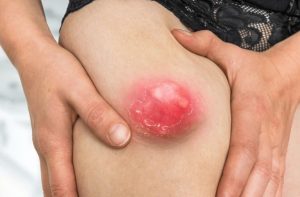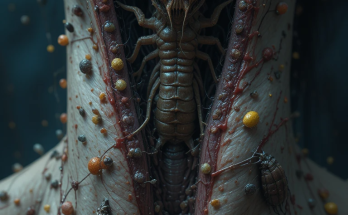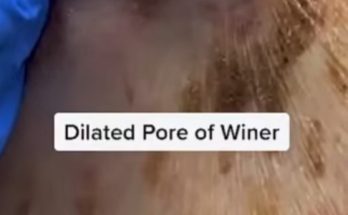“How to Treat and Prevent Big Pimples: Solutions for Clear Skin”( Full Video)

What is cystic acne?
Cystic acne is a type of inflammatory acne that causes painful, pus-filled pimples to form deep under the skin. Acne occurs when oil and dead skin cells clog skin pores.
With cystic acne, bacteria also gets into the pores, causing swelling or inflammation. Cystic acne is the most severe type of acne. Acne cysts are often painful and more likely to cause scarring.
What’s the difference between an acne cyst and an acne nodule?
Nodular acne and cystic acne are very similar. Both cause deep, painful bumps under the skin. And both can scar. Differences include:
Acne cysts are filled with pus, a fluid.
Acne nodules are more solid and harder than acne cysts because they don’t contain fluid.
Symptoms and Causes
What causes cystic acne?
Pores in the skin can clog with excess oil and dead skin cells, causing pimples. Bacteria can enter the skin pores and get trapped along with the oil and skin cells. The skin reaction causes swelling deep in the skin’s middle layer (the dermis). This infected, red, swollen lump is an acne cyst.
Cystic acne causes include:
Age (teenagers are more prone to cystic acne).
Family history of cystic acne.
Hormone changes during the teenage years and sometimes during menopause, and stress.
What does cystic acne look like?
Acne cysts resemble boils, a type of skin infection. An acne cyst may be:
A red lump under the skin.
Painful or tender to touch.
Small as a pea or big as a dime.
Oozing pus from a whitish-yellow head.
Crusty.
Where do acne cysts develop?
A cystic acne breakout may cover a large area of skin. Cystic acne tends to appear on the face, which has a lot of oil glands. But you can also get acne cysts on your:
Back.
Butt.
Chest.
Neck.
Shoulders.
Upper arms.
Diagnosis and Tests
How is cystic acne diagnosed?
A dermatologist, a doctor who specializes in skin conditions, can examine your skin and make a cystic acne diagnosis.
Management and Treatment
How is cystic acne managed or treated?
Acne cysts can be difficult to treat. Because they can scar, you should seek help from a dermatologist instead of trying over-the-counter acne products. A dermatologist can teach you how to treat cystic acne.
It can take three months or more to clear up acne cysts. Treatment often involves taking oral antibiotics and applying prescription-strength topical gels or creams to the skin.
Cystic acne treatments include:
Antibiotic creams, gels solutions and lotions to kill bacteria and decrease inflammation.
Azelaic acid (Azelex®, Finacea®) or salicylic acid to kill bacteria and get rid of excess dead skin cells.
Benzoyl peroxide to reduce the number of bacteria on the skin.
Retinoids (adapalene, tretinoin, tazarotene among others), vitamin A derivatives that help slough dead skin cells.
What are other cystic acne treatments?
Other treatments for cystic acne include:
Corticosteroid injections: Used to quickly shrink large, painful acne cysts.
Incision and draining: Helps to open up an acne cyst and drain the pus.
Birth control pill or spironolactone: Used by women to lower hormone levels that cause cystic acne.
Isotretinoin: An oral retinoid (most commonly called Accutane).
What are the complications of cystic acne?
Opening up acne cysts — by popping or picking them — increases the risk of scarring and bacterial skin infections like cellulitis.
Some people develop pigment changes (light or dark) spots at the site of the acne cyst after the skin clears up. These spots may be pink, purple, red, black or brown. They eventually fade away, but it may take more than a year.
Prevention
How can I prevent cystic acne?
You can lower your risk of getting acne by taking these steps:
Use a mild foaming facial cleanser, lukewarm water and your fingers (not a washcloth or sponge) to wash your face after you wake up, before going to bed and after exercising or sweating.
Apply oil-free moisturizer if you feel dry.
Use noncomedogenic (water-based) makeup and facial products.
Don’t sleep in makeup.
Keep your hands away from your face during the day.
Don’t pick at or pop pimples or scabs.
Wash your hair regularly and keep hair (which can be oily) away from your face.
Occasionally oily environments, such as working at a fast food restaurant, can contribute to acne flares.
Diets high in simple sugars and dairy, also called a high glycemic index diet, may contribute to flares as well.
Outlook / Prognosis
What is the prognosis (outlook) for people who have cystic acne?
Most people with cystic acne can prevent severe breakouts or quickly treat acne cysts to prevent scarring. Often, but not always, cystic acne clears up or diminishes with age, as hormones settle down.
Severe or untreated cystic acne can affect how you feel about your appearance, making you anxious or depressed. If cystic acne bothers you, talk with your healthcare provider about getting help with fostering a positive self-image.
Living With
When should I call the doctor?
You should call your healthcare provider if you experience:
Swollen, red, painful pimples.
Acne or scarring that makes you feel self-conscious.
Signs of a skin infection.
What questions should I ask my doctor?
You may want to ask your healthcare provider:
What causes cystic acne?
What is the best cystic acne treatment?
What are the treatment side effects?
How can I lower my chances of getting acne cysts?
How can I prevent scarring or other complications?
A note from Cleveland Clinic
It’s tempting to want to touch or pick at painful, swollen acne cysts. But cystic acne is more likely than other zits to scar or develop infections. A dermatologist can offer suggestions to prevent cystic acne. This doctor can also treat painful acne cysts, lowering the chances of scarring. Antibiotics and topical (skin) creams are effective cystic acne treatments.
Don’t Pop It: As tempting as it may be, popping a pimple can cause scarring, more inflammation, and potentially lead to an infection.
Use Spot Treatment: Apply a spot treatment that contains ingredients like benzoyl peroxide, salicylic acid, or sulfur to reduce the size and redness of the pimple.
Apply Ice: Ice can help reduce swelling and inflammation. Wrap a clean cloth around an ice cube and gently apply it to the pimple for a few minutes at a time.
Cleanse Gently: Use a gentle, non-comedogenic cleanser to avoid irritating the skin further. Over-washing can make things worse.
Use Retinoids: Over-the-counter or prescribed retinoid creams can help prevent pores from becoming clogged and reduce inflammation.
Don’t Over-Exfoliate: While exfoliating can help remove dead skin cells, doing it too often can worsen irritation. Stick to once or twice a week if you choose to exfoliate.
See a Dermatologist: If you’re dealing with persistent or very large pimples, it might be a good idea to consult with a dermatologist. They can offer treatments like cortisone injections or recommend stronger medications.
1. Avoid Popping Pimples
Popping pimples can make things worse. It pushes bacteria deeper into the skin and increases the risk of scarring and infection. When you pop a pimple, you also risk spreading the bacteria, which can cause more pimples to form around the affected area. In fact, a study published in the “Journal of Clinical and Aesthetic Dermatology” found that manipulating or squeezing pimples can lead to permanent scarring and worsening of the condition (Journal of Clinical and Aesthetic Dermatology, 2012).
What to do instead: Use treatments that target the pimple directly (like spot treatments) rather than picking at it.
2. Use Spot Treatments
Spot treatments containing active ingredients like benzoyl peroxide, salicylic acid, and sulfur are commonly recommended to treat pimples effectively.
Benzoyl Peroxide works by killing the bacteria responsible for acne (Propionibacterium acnes) and can reduce inflammation. According to the American Academy of Dermatology (AAD), benzoyl peroxide can help clear up pimples within a few days to weeks (AAD, 2021).
Salicylic Acid is a beta-hydroxy acid (BHA) that works by exfoliating the skin and unclogging pores. It’s particularly useful for acne that’s due to clogged pores. The Journal of Clinical and Aesthetic Dermatology notes that salicylic acid can be helpful in reducing both blackheads and whiteheads (Journal of Clinical and Aesthetic Dermatology, 2011).
Sulfur helps dry out excess oil and reduces the size of the pimple, making it a gentle option for sensitive skin.
3. Apply Ice for Swelling
Applying ice or a cold compress to a big pimple can reduce swelling and inflammation. The cold constricts blood vessels and helps minimize redness and puffiness.
A study from the “Journal of Dermatology” indicates that cold compresses can reduce inflammation and provide temporary relief for inflamed acne lesions (Journal of Dermatology, 2008).
4. Gentle Cleansing
It’s important to cleanse your skin gently to avoid irritating your pimple further. Over-washing your face or using harsh scrubs can strip the skin of its natural oils and cause the skin to produce more oil, which can clog pores and worsen acne.
The American Academy of Dermatology advises that you use a mild, non-comedogenic cleanser that doesn’t contain alcohol or harsh chemicals that can dry out or irritate the skin (AAD, 2021).
Tip: Wash your face twice a day, and avoid scrubbing or using abrasive facial brushes.
5. Use Retinoids
Retinoids, derived from Vitamin A, are one of the most effective treatments for acne. Retinoids like retinol or prescription-strength tretinoin help unclog pores, reduce inflammation, and prevent future breakouts by speeding up cell turnover.
Research in the “Journal of Dermatology” found that topical retinoids effectively reduce both non-inflammatory and inflammatory acne, including cystic acne (Journal of Dermatology, 2014).
6. Avoid Over-Exfoliating
While exfoliating can be beneficial for removing dead skin cells and preventing clogged pores, over-exfoliating can irritate the skin and trigger more breakouts. It’s important to exfoliate gently and not more than once or twice a week.
A study published in “Dermatologic Therapy” suggests that over-exfoliation can impair the skin’s natural barrier, leading to increased irritation and potential acne flare-ups (Dermatologic Therapy, 2012).
7. Consult a Dermatologist
If you’re dealing with persistent or severe acne, it’s a good idea to consult with a dermatologist. They can prescribe stronger treatments like oral antibiotics (e.g., doxycycline) or more potent topical treatments. For large cystic acne, cortisone injections are often used to reduce inflammation and shrink the pimple quickly. A dermatologist can also recommend treatments like chemical peels or laser therapy for stubborn acne.
Reference for Cystic Acne Treatment: The American Academy of Dermatology emphasizes the importance of seeing a dermatologist for cystic acne, as over-the-counter treatments are often insufficient for this type of severe acne (AAD, 2021).
Daily Skincare Tips to Prevent Breakouts
Cleanse twice a day with a gentle, non-comedogenic cleanser.
Moisturize regularly to maintain skin hydration (even oily skin needs moisture).
Use sunscreen daily to protect your skin from UV damage, which can make acne scars worse.
Avoid touching your face or picking at pimples to reduce bacteria spread and irritation.
Stay hydrated and follow a balanced diet rich in antioxidants to support overall skin health.
References
American Academy of Dermatology (AAD). (2021). “Acne: Diagnosis and Treatment.” American Academy of Dermatology.
Journal of Clinical and Aesthetic Dermatology. (2012). “Popping Pimples and Scarring.” Journal of Clinical and Aesthetic Dermatology.
Journal of Dermatology. (2008). “The Use of Cold Compresses for Acne Inflammation.” Journal of Dermatology.
Journal of Clinical and Aesthetic Dermatology. (2011). “Salicylic Acid and Its Role in Acne Treatment.” Journal of Clinical and Aesthetic Dermatology.
Dermatologic Therapy. (2012). “Over-Exfoliation and Skin Irritation.” Dermatologic Therapy.
1. Topical Treatments for Pimples
Benzoyl Peroxide
How it works: Benzoyl peroxide helps kill the bacteria that cause acne, reduces inflammation, and clears blocked pores. It’s highly effective for inflammatory acne.
How to use: Start with a lower concentration (2.5% to 5%) to reduce the risk of irritation. Apply a thin layer directly on the pimple after cleansing. Avoid using on large areas at first.
Products: Clean & Clear Advantage Acne Spot Treatment or Neutrogena On-the-Spot Acne Treatment.
Salicylic Acid
How it works: Salicylic acid is a beta-hydroxy acid (BHA) that penetrates deep into the pores to dissolve the oil and dead skin cells that clog them. It’s especially useful for treating comedonal acne (blackheads and whiteheads) and reducing inflammation.
How to use: Apply directly to the pimple after washing your face. You can use products that contain 1-2% salicylic acid.
Products: Paula’s Choice Skin Perfecting 2% BHA Liquid Exfoliant or Neutrogena Oil-Free Acne Stress Control Triple-Action Toner.
Retinoids (Retinol or Tretinoin)
How it works: Retinoids (Vitamin A derivatives) speed up cell turnover, helping to prevent clogged pores, reduce inflammation, and promote faster healing of pimples.
How to use: Start by using a pea-sized amount of retinol or tretinoin every other night, as it can be drying. Apply it at night only because retinoids can make your skin more sensitive to the sun.
Products: Differin Gel (Adapalene 0.1%) (OTC) or Retin-A (prescription strength).
2. Spot Treatments for Targeted Action
Sulfur
How it works: Sulfur is known for its ability to absorb excess oil and dry out pimples. It also has antibacterial properties.
How to use: Apply a small amount of sulfur treatment directly to the pimple, allowing it to dry out the area.
Products: Mario Badescu Drying Lotion or De La Cruz Sulfur Ointment.
Tea Tree Oil
How it works: Tea tree oil has antimicrobial properties that can help kill the bacteria responsible for acne. It’s also a more natural solution for treating pimples.
How to use: Dilute tea tree oil with a carrier oil (like coconut oil or jojoba oil) and apply a drop directly to the pimple.
Products: The Body Shop Tea Tree Oil or Thursday Plantation Tea Tree Oil.
3. Medical Treatments for Severe Pimples (Cystic Acne)
Cortisone Injections
How it works: A dermatologist can inject a diluted form of cortisone directly into a cystic pimple. This quickly reduces inflammation and helps the pimple shrink in size, sometimes within a day or two.
How to use: This is a procedure that must be done by a dermatologist. It’s especially helpful for large, painful cystic acne that doesn’t respond to over-the-counter treatments.
Oral Medications
Oral Antibiotics: Medications like doxycycline or minocycline are often prescribed for severe acne. They work by reducing bacteria and inflammation.
How to use: Follow the dermatologist’s instructions for dosage and duration, usually for several months.
Products: Available by prescription only.
Isotretinoin (Accutane)
How it works: Isotretinoin is a powerful oral medication used for severe cystic acne that doesn’t respond to other treatments. It works by reducing the size of oil glands, preventing clogged pores, and reducing inflammation.
How to use: This medication is prescribed by a dermatologist and requires regular follow-up visits due to potential side effects. It’s generally used for several months and can lead to permanent improvements.
Important Notes: Women must avoid pregnancy during treatment due to the high risk of birth defects.
4. Home Remedies for Temporary Relief
Ice Compress
How it works: Ice reduces inflammation and redness. It can provide instant relief for painful pimples.
How to use: Wrap ice in a clean cloth and apply it to the pimple for about 10 minutes. Do this several times a day as needed.
Honey and Cinnamon Mask
How it works: Honey has antibacterial properties, and cinnamon helps to increase blood circulation, which can promote healing. This can be an effective natural remedy for acne.
How to use: Mix 2 tablespoons of honey with 1 teaspoon of cinnamon powder to make a paste. Apply the mixture to the pimple and leave it on for about 10-15 minutes before rinsing off.
Aloe Vera Gel
How it works: Aloe vera has anti-inflammatory properties that can help reduce redness and swelling associated with acne.
How to use: Apply fresh aloe vera gel directly to the pimple, leave it on for 15-20 minutes, and then wash off with cool water. Repeat 2-3 times daily.
5. Preventive Measures
Maintain a Consistent Skincare Routine
Cleanse Twice Daily: Use a gentle cleanser to wash your face twice daily (morning and night) to remove dirt, oil, and makeup.
Moisturize: Even oily skin needs moisture. Use an oil-free, non-comedogenic moisturizer to prevent the skin from overcompensating by producing more oil.
Sunscreen: Use a non-comedogenic sunscreen daily to protect your skin from harmful UV rays, which can worsen scarring.
Healthy Lifestyle Choices
Stay Hydrated: Drink plenty of water to keep your skin hydrated and flush out toxins.
Diet: Avoid excessive sugar and dairy intake, as some studies suggest that they can exacerbate acne in certain people.
Manage Stress: Stress can trigger acne flare-ups, so practicing relaxation techniques (like yoga, meditation, or deep breathing) can be beneficial.
Conclusion
For big pimples or cystic acne, over-the-counter treatments (benzoyl peroxide, salicylic acid, and retinoids) are great for mild to moderate acne. For more severe cases, you may need professional treatment like cortisone injections, oral medications, or even Accutane. Additionally, adopting a consistent skincare routine, eating healthily, and practicing stress management can help prevent future breakouts.

